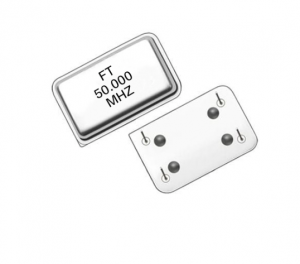What are the types of crystal oscillators?
Crystal oscillator:
An electronic circuitry component known as a crystal oscillator is responsible for generating an electrical signal with an exceedingly precise frequency. It is achieved by using a piezoelectric crystal with mechanical resonance. In the late 1920s, the first crystal oscillator was developed by Walter Guyton Cady, a pioneer in the area of ultrasonic submarine detection.
Crystal oscillators are the most common linear oscillators; however, there are other types. Quartz is the most common material used to manufacture them, and the frequency at which an oscillator function is determined by the frequency at which it is made. These devices provide a variety of additional applications in the industrial sector, including the generation of clock signals for use in microcontroller-based systems and microprocessor-based devices, such as radios, clocks, and watches. Due to their small size and inexpensive cost, crystal oscillators are used widely in various electronic warfare and communication systems.
So, “What are the types of crystal oscillators” Crystal oscillator circuits may take many forms. Some common ones are the oscillator contained with the package, TCXO, crystal oscillator capable of voltage regulation, frequency-controlled crystal oscillator, and oven-controlled crystal oscillator.
What are the types of crystal oscillators:
Read carefully! In this section, we have explained “What are the types of crystal oscillators” in detail.
Oscillator Crystal Contained Within a Package:
Oscillator Crystal Contained Within a Package (SPXO) is an oscillator with no temperature adjustment or regulating mechanisms. Crystal units typically have a cubic frequency-temperature characteristic, and the AT-cut technique is one of the most frequently used cutting methods. The frequency-temperature curve of an oscillator exhibits a cubic form, much like the curve of a crystal unit, with a nearly identical relationship. The role of reference oscillators in communications equipment, measuring instruments, and controllers are only a few examples of common uses for basic packed crystal oscillators. In addition to computers, office automation equipment, and information terminals, they are also used in these devices in the capacity of an oscillator for the clock.
In an OCXO, the crystal and other oscillator components must be kept at a constant temperature even when the surrounding environment changes. You may compare temperature changes to a thermostat in the home that recognizes a temperature change and adjusts the furnace to maintain a desired temperature in the wintertime.
A Temperature Compensation Crystal Equipped Oscillator (TCXO)
Temperature Compensation Crystal Equipped oscillators function reliably throughout a wide temperature range by including temperature-compensation circuits into their internal architecture. The most frequent approach to locating temperature-compensated thermistors is in the form of an integrated circuit (LSI) that contains both thermistors and temperature-compensated circuitry. However, temperature-compensated thermistors may be discovered in several other ways as well. Crystal oscillators incorporated into an LSI and feature temperature-compensated circuitry are often called single-chip oscillators. This kind of oscillator is the industry standard.
Temperature-compensated crystal oscillators exhibit the temperature properties of the crystal. The TCXO provides a wide temperature range in addition to low power consumption. Aside from that, it is easy to transport, compact, and has a fast start-up. Consequently, it is used in various measurement equipment and communication devices, such as mobile phones, global positioning systems (GPS), land mobile radio systems, microwave transmission, and satellite communications. A TCXO is another type of voltage-controlled TCXO (Voltage-Controlled TCXO) fueled by an external source and can change its frequency (VC, AFC).
Crystal Oscillator, Capable of Voltage Regulation:
An oscillator, known as a voltage-controlled crystal oscillator, or VCC for short, has a predetermined frequency but can be changed by increasing the control voltage to bring about a very little shift in the frequency.
A VCXO oscillator has various properties, each of which may be characterized uniquely. The most critical parameters are the pulling range, the center frequency, the tuning voltage range, and the output jitter.
When the control voltage of the VCXO shifts from one value to another, we say that the tuning voltage has a broad range. This voltage acts as a controller for the capacitance that the varactor has. A typical voltage range is 0 V to 2 V, or 3 V. The output frequency range of the VCXO has a center frequency, which refers to the frequency located in the middle of this range. The pulling capacity is the proportion of the up (or down) frequency variation to the signal’s center frequency. The most common unit of measurement for this ratio is parts per million (ppm) (part per million). This measurement has the potential to identify the relative pulling range of the VCXO. Most VCXOs and crystals typically have to pull ranges that fall between 100ppm and 200ppm.
Frequency Controlled Crystal Oscillator (FCXO)
Frequency Controlled Crystal Oscillator (FCXO) is excellent for converting frequencies as well as synchronizing those of transmission equipment. It is possible to synchronize the output frequencies of a frequency-controlled crystal oscillator module with the standard input frequencies of an external source.
Oven-Controlled Crystal Oscillator (OCXO)
Oven-controlled crystal oscillators offer more extraordinary temperature characteristics than those that are not oven-controlled. A thermostatic oven maintains a constant temperature in the crystal unit. To keep the temperature at a level of consistency that is enough for a quartz crystal to perform its intended functions, OCXO is necessary.
The temperature of the quartz crystal housed inside a crystal oven directly impacts the frequency you can extract from the stove. It is possible for the temperature to have a significant influence on the oscillator’s frequency, as the example that comes after this one demonstrates.
The use of an oven-controlled crystal oscillator, ideally suited for mobile base stations and spectrum analyzers, may be of significant advantage to reference oscillators, such as those used in spectrum analyzers and mobile base stations, respectively.
Conclusion:
Do you want better temperature and frequency stability? You may require a crystal oscillator for it. If you are missing a sumptuous crystal oscillator in your daily life, you should visit CHINACHIPSUN. Our crystal oscillators are the best and most durable option for new advancements and replacements. Discover our crystal oscillator and have a look at our products!

